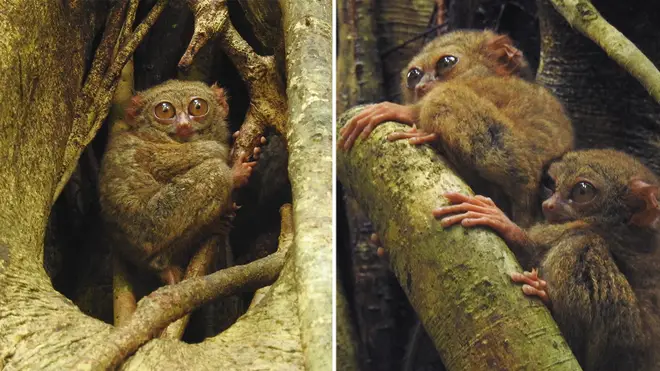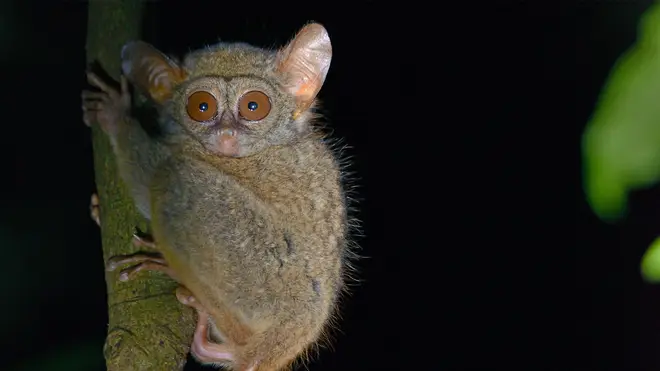Scientists record the tiny, monkeylike tarsiers that sing virtuosic duets together
23 August 2022, 17:23 | Updated: 24 August 2022, 16:54

After eavesdropping on their operatic duets, scientists found these tiny primates could be using their vocal virtuosity to attract a mate.
Gursky’s spectral tarsiers are a pint-sized species of primate that bear a strikingly close resemblance to Yoda in Star Wars. They were even, supposedly, the original inspiration for the Jedi Master.
The tarsiers, which inhabit the island of Sulawesi in Indonesia, are also known for their virtuosic vocal duets.
In a recent study, led by researchers from Sam Ratulangi University in Indonesia and Cornell University in the United States, it was found that pairs of the tarsier species sing duets that have evolved to showcase their virtuosity.
The ‘songs’ they perform can be taxing work for the singing creatures, presumably due to physiological constraints. Researchers deduced that the complexity of their music-making may directly correspond to their ‘fitness’ as signalled to other members of the same species – just as a peacock’s tail might.
Read more: NASA releases eerie ‘singing’ from a black hole and it’s straight out of a horror movie

Alongside her colleagues, first author of the study Isabel Comella, a researcher at the K Lisa Yang Center for Conservation Bioacoustics, recorded 50 duets consisting of 6,681 notes, sung by 14 female-male pairs of Gursky’s spectral tarsiers.
Using machine learning, they analysed the notes and phrases from each tarsier’s song, paying attention to frequency, bandwidth, duration and rate of notes per second. The study took place in the months of July and August 2018, in Tangkoko National Park in North Sulawesi.
“Here we show that Gursky’s spectral tarsier duets exhibit acoustic trade-offs in note rate and note bandwidth – that is, the range of frequencies within a note,” Comella said.
“To produce high-frequency notes with wide bandwidths, Gursky’s spectral tarsiers must make rapid and comprehensive vocal modifications, which may be physically demanding. So, on average, we find that duets with a wide bandwidth tend to have notes that are repeatedly more slowly, and vice versa.”
The duets lasted between 13 and 204 seconds, and often featured what the researchers observed to be the tarsiers’ version of an opera singer’s coloratura: rapidly repeated notes, vocalised in a duet-like manner between male and female pairs.
Hear a ‘duet’ between a female and male tarsier pair on North Sulawesi, in the video below.

Tarsiers push virtuoso singing to their physiological limits
“The duet is rich in rapidly repeated broadband notes, which are physiologically and neurologically taxing for the singer,” Comella added. “An individual’s ‘virtuosity’ in singing these notes may be the equivalent of a peacock’s tail, signalling fitness.”
The Gursky’s spectral tarsiers’ singing style varies from one creature to the next. Some can sing a few notes that stretch over the widest bandwidth, while others achieve rapid repetitions of several notes – but only a handful can do both at the same time.
The nocturnal primates, which weigh between 100 and 200g, move around in pairs, occupying territories of between 1.6 and 4.1 hectares, which they defend by singing duets – revealing that they already have a mate, and the territory is occupied.
The researchers also found in their study, that singing broadband notes in rapid succession is especially difficult for the female tarsier, but it is not yet known why.
“There is still so much to be learned about the function of tarsier duets: the information they contain about the calling animals, and what information other tarsiers pick up on. The possibility that duets contain information about the fitness of a calling individual – the vocal equivalent of a peacock’s tail – is an exciting avenue for future research,” said last author Dr. Dena J Clink, a researcher at the K Lisa Yang Center.
“Tarsiers are understudied compared to their more ‘popular’ primate relatives, so they represent a vast area of research yet to be explored. For example: Do their duets accurately reflect their fitness? What exactly are the different functions of their duets? We hope to answer some of these questions in our future studies,” concluded Comella.









































